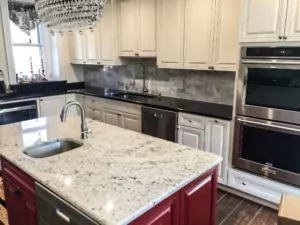 One of the reasons natural stone countertops are such a great investment is because they last. According to the National Association of Home Builders (NAHB), stone countertops are rated as able to last a lifetime, over 100 years are more. That’s over twice as long as most other materials — talk about getting some bang for your buck!
One of the reasons natural stone countertops are such a great investment is because they last. According to the National Association of Home Builders (NAHB), stone countertops are rated as able to last a lifetime, over 100 years are more. That’s over twice as long as most other materials — talk about getting some bang for your buck!
There is a little bit of a catch, however. The lifespan of your stone countertop depends heavily on how well you maintain it. As we’ve talked about many times before, natural stone is a porous material that can absorb water, food particles, and other debris over time. This can weaken the stone and can eventually lead to breakage. In addition, most soft stones like marble, limestone and sandstone are prone to acid etching and degradation, as well as scrapes and scratches. Although these things won’t necessarily affect the overall longevity of your countertop per se, if you leave your countertop unsealed for years at a time and frequently use damaging acidic materials and harsh cleaners, it can certainly make your stone more susceptible to breakage.
Out of all your options for a natural stone countertop, granite and soapstone are the most durable and will last the longest. Both are incredibly strong, scratch-resistant, resistant to thermal shock and are not susceptible to heat damage. Although granite has some porosity and can absorb liquids and debris if not re-sealed periodically, soapstone is not porous and doesn’t really need to be sealed. Granite is more resistant to scratches and chipping than soapstone, but both are strong and can withstand heavy loads. However, it’s important to keep in mind that the stones are strong but also inflexible, meaning they can still break if struck with enough force. Thankfully, both granite and soapstone can likely take whatever you can throw at it, but do be careful not to drop any bowling balls or jump up and down on your countertops — just in case.
Although marble isn’t a great option for a high-traffic kitchen countertop, it’s still a very durable material and can last a lifetime if you keep up with the material’s more frequent need for resealing. Marble, limestone, and sandstone are more porous than granite and more readily etch and stain which, as we said above, can lead to breakage if left exposed over long periods of time. These softer stones are also much more prone to scratching and chipping, so be careful not to cut directly on the surface and be careful when setting down heavy items.
It may come as a surprise that partially-synthetic stone countertops like quartz and cultured marble tend to have a much shorter lifespan than natural stone. One might think that the resins used to bind the stone dust or chips together make the countertop impervious to damage, but this material comes with its own cons. Although the resins make the countertop nonporous, they’re more susceptible to heat and sun damage, as well as damage from strong household cleaners. As with natural stone countertops, synthetic options can still last a very long time if maintained properly, but it’s also worth highlighting that even though natural stone comes with a higher price tag, over time you’ll likely be saving more money than with other options.
Don’t forget, your stone countertop has actually been around for thousands of years before it arrived in your home. Many of the world’s most beautiful and historic buildings are built out of marble, granite, limestone, and other incredible stones, and have been able to withstand the elements while still standing tall. So, your stone countertop will likely be able to withstand even your most involved cooking projects. That being said, a little regular maintenance goes a long way in ensuring your countertop lasts a lifetime. Want to know how you can avoid damage? Check out our previous post!

